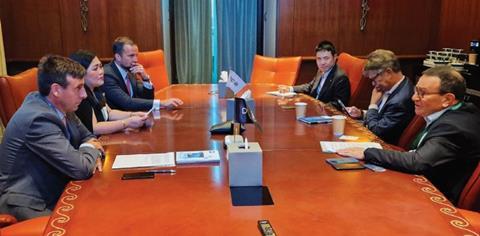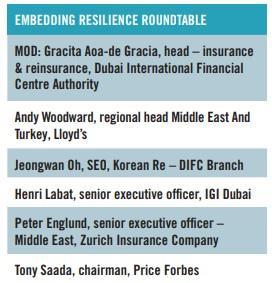At a closed-door roundtable hosted by DIFC, our re/insurance experts tackled the shape of resilience across the sector – debating AI, cyber, MGAs, and Middle East growth – and why evolving risks continue to the industry’s biggest opportunities.
Senior regional and global re/insurance industry leaders gathered to discuss the next chapter in resilience-building across the insurance sector at a closed-door roundtable hosted by the Dubai International Financial Centre (DIFC) Authority during DWIC 2025.

The session, held under the Chatham House rule, featured frank exchanges on cyber risk, artificial intelligence, the evolving managing general agent (MGA) model, and emerging opportunities in the Middle East. The DIFC’s head of insurance and reinsurance, Gracita Aoa De Gracia, moderated the session.
The event coincided with the publication of a DIFC–Asia House executive report titled Embedding Resilience: Opportunities in the Global Insurance Industry, which formed a backdrop to the discussion.
Geopolitics, cyber, climate – risks and opportunities
A series of early contributions from participating carriers focused on the interplay between geopolitical volatility, cyber exposures and climate change—and the expanding opportunities these present for insurers that can adapt.
One participant described the industry’s ability to thrive on uncertainty as a defining trait. “Insurance survived the world wars and the global financial crisis. Change creates risk, and risk creates opportunity.”
Cyber was identified as a line of business poised for dramatic growth, not only due to escalating ransomware, phishing and system outage risks, but also because of better awareness and interest among clients. “Cyber is no longer an IT issue—it’s an enterprise-wide risk.
Another speaker underlined the widening protection gap: “Cat losses hit over $140bn in 2024, and the insured portion was only a fraction of the economic total. It’s similar with cyber – trillions in losses globally, and the insurance market is barely scratching the surface.”
Middle East growth underpinned by infrastructure and regulation
The DIFC’s positioning as a growth hub for international re/insurance came through strongly in the discussion. Multiple speakers praised its regulatory framework for enabling rapid market entry, particularly for MGAs.
“The MGA model works incredibly well in this region,” one contributor said. “You can launch with a lean team and scale fast. That flexibility is essential in a relatively small but fast-growing market.”
Others were more cautious, arguing that MGAs only add value when there’s a capacity shortage or specialist knowledge. “If the MGA isn’t offering a product or service, we can’t provide in-house, the value proposition weakens—especially at claims time,” said one insurer.
Yet there was broad agreement that a healthy mix of traditional carriers, MGAs, brokers and insurtechs is what has driven DIFC’s rapid growth—from $2.6bn to $3.5bn in premium over a few years.
One participant added: “We’re seeing global talent relocating to the DIFC. That’s sucking in business that used to go elsewhere. Growth isn’t just about product—it’s also regional and structural.”
AI transforms back and front office, with limits
When the conversation turned to artificial intelligence, there was little doubt among participants that its use is accelerating. “We don’t have a choice. AI is now essential if we want to stay competitive,” one executive said.
AI is already driving operational efficiency, particularly in back-office functions such as claims handling, accumulation analysis and credit control. On the front end, participants cited the use of AI in distribution and pricing across retail and SME segments, especially for personal lines.
However, several voices urged caution. “In complex commercial lines, the human decision-maker still matters. AI will support, not replace, underwriting—at least for now,” said one.
Another warned that a glut of AI-led market followers could undercut underwriting discipline: “In the short term, I see AI significantly impacting follow markets. Leads will hold the line—for now.”
Green energy, infrastructure and specialty opportunities
Discussion turned to specific growth areas. Several participants pointed to the wave of infrastructure and renewable energy projects across the Gulf, particularly in Saudi Arabia and the UAE.
“Demand for construction insurance is surging,” one said. “And property, energy and renewables are all growing rapidly. These are still conventional lines, but with new layers of complexity.”
Specialty lines such as cyber, political violence, event cancellation and directors’ and officers’ liability were also cited as areas where underwriters are finding new traction.
The DIFC was praised for preparing the ground, making the region more attractive for insurers to underwrite these risks locally as more regional buyers drive demand.
One speaker noted that lower penetration levels mean even mature products like D&O still offer big growth opportunities: “Saudi insurance penetration is still well below the UAE – that means big room for growth.”
Resilience through relevance and talent

In the final segment, participants stepped out from anonymity to offer closing thoughts on how to continue to promote sustainable re/insurance market growth and resilience.
Tony Saada, chairman of Price Forbes Dubai, spotlighted overlooked areas of opportunity.
“We don’t talk enough about medical or life insurance. With rising demographic shifts such as aging populations and infl ation in treatment costs, this is a major area for growth. Climate change will also hit agriculture yields. Markets should be looking at better agricultural cover solutions.”
He also noted the emergence of insurance-linked securities.
“Alternative capital is reshaping the reinsurance landscape. Brokers and MGAs will increasingly tap fi nancial markets to back capacity. The future is strong – and our industry is one of the most resilient in the world.”
Andy Woodward of Lloyd’s emphasised the sector’s talent crunch.
“We can’t keep growing at 25–30% a year if everyone is recruiting from the same talent pool. The biggest risk to our market here in the DIFC is a lack of people,” he said.
Korean Re DIFC’s Jeongwan Oh echoed the need for tools and preparation: “There are opportunities, but linking them to healthy growth requires readiness in modelling, pricing, and cyber capabilities.”
Peter Englund of Zurich Insurance in the Middle East noted the region’s macroeconomic advantages.
“We’re fortunate to operate in a region with strong fundamentals. The DIFC plays a key role in enabling us to manage those risks effectively. As an industry, we should focus not just on products, but also on resilience services that keep us relevant and forward looking,” he said.
Henri Labat at IGI Dubai added a comment about the DIFC’s evolution.
“We’re lucky to work in such a dynamic market. But future growth depends on attracting the right talent,” he said, adding: “What’s been built here over 20 years is remarkable – and we must build on that.” The roundtable concluded with praise for DIFC’s ongoing mission. As one speaker said earlier in the session: “Resilience isn’t just about surviving shocks – it’s about preparing for what comes next.”










No comments yet